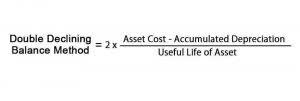
Organizations with substantial unrestricted net assets are better equipped to navigate through difficult times without resorting to drastic measures such as layoffs or program cuts. This stability fosters confidence among stakeholders, including employees, bookkeeping and payroll services investors, and creditors. Reclassification of net assets is a process that nonprofits must navigate carefully to ensure compliance with accounting standards and donor intentions.
- It wouldn’t be fair to subtract fixed assets from the equation in step two if you didn’t get to add the related liabilities back in.
- The impact of unrestricted net assets on long-term stability is a crucial aspect to consider when examining the fiscal sustainability of an organization.
- These entries ensure that the financial records reflect the true state of the nonprofit’s finances.
- Nonprofits frequently encounter various scenarios where temporarily restricted net assets are released, each with its own set of implications and opportunities.
- From the perspective of nonprofit organizations, unrestricted net assets are particularly significant as they represent funds that can be utilized for any purpose deemed necessary by the organization’s leadership.
- Net assets on the balance sheet fall into several categories, including temporarily restricted, permanently restricted and unrestricted net assets.
Monitoring Nonprofit Performance
If you have assets that exist due to receipts from temporarily restricted net assets campaigns (ex. money raised for a capital campaign), then subtract those next. These assets are typically unrestricted, but don’t contribute to your Readily Available Net Assets. If the money for your receivables isn’t going to be used for everyday operating costs, then subtract it from this number. When you think you are done, give your value a reasonableness test – this is the most difficult step in the process. Does it make sense that you have cash, short-term investments, prepaids and some operating receivables left over?

What Are Unrestricted Net Assets on the Balance Sheet for Fund Accounting?
Understanding net assets is critical to assessing an organization’s financial strength. We love all kinds of net assets, though we have a special place in our hearts for unrestricted net assets. The notes at the back of the financial statements will include detailed information on the nature and amounts of restricted net assets. Similarly, “net assets with donor restrictions” is the official terminology for restricted net assets. Consider a small business facing an unexpected increase in production costs due to supply chain disruptions. If they have built up sufficient unrestricted net assets, they can tap into these reserves to cover the what are retained earnings additional expenses and maintain their profitability until normalcy is restored.

First, some important differences between for profit and non-profit accounting
- The reclassification process also involves updating financial statements to reflect the change in the nature of the net assets.
- If a small or midsize nonprofit does have an endowment, the donor often requires that the income generated from the gift be used for operations or for a specific purpose.
- Transparency in this process is crucial, as it demonstrates the nonprofit’s commitment to honoring donor restrictions and maintaining financial integrity.
- Unrestricted funds can be generated through general donations, fundraising events, or revenue from services provided.
- Even if you did sell, you’ll likely get sale proceeds different than the $50,000 carrying value.
Managing permanently restricted net assets involves careful investment strategies to ensure the principal’s preservation while generating sufficient income to meet the donor’s objectives. This type of asset requires meticulous record-keeping and transparent reporting to demonstrate adherence to the donor’s long-term vision. Nonprofit organizations play a crucial role in addressing societal needs, often relying on donations and grants to fund their activities. Effective financial management is essential for these entities to maintain unrestricted net assets trust with donors and ensure long-term sustainability.

Further, providing a single lump sum balance for net assets without donor restrictions often does not tell the full story. For instance, the total net asset balance in all three examples below is $100,000. Net assets with donor restrictions is due to the $40,000 in cash, all of which is from a restricted grant, and the $10,000 grant receivable. Perhaps the donation is to be used on a specific project or to pay for a specific need the non-profit has.
Positive unrestricted net assets indicate that an organization has generated more revenue than it has spent over time, while negative unrestricted net assets suggest ongoing financial challenges. Unrestricted net assets are donations to nonprofit organizations that have no strings attached. That is, the assets may be used by the organization for general expenses or any legitimate expenditure. The agency uses these funds to pay general expenses or to fund specific purposes of the group. The donor contributes the funds and allows the agency to make all decisions regarding the money’s use.
Endowment Funds and Permanently Restricted Net Assets
This section delves into various strategies that can be employed to achieve these goals, offering insights from different perspectives within the field. By implementing these strategies, organizations can not only strengthen their financial position but also secure their ability to fulfill their mission and serve their stakeholders effectively. From a financial perspective, unrestricted net assets provide a cushion against unexpected expenses or economic downturns. They serve as a reserve that can be utilized to cover operational costs, invest in growth opportunities, or weather unforeseen challenges.

